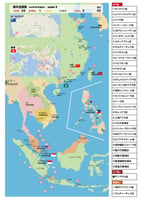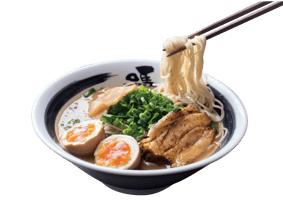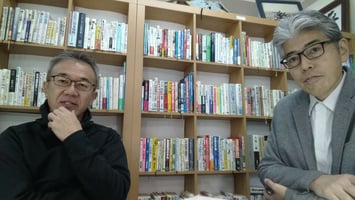最近、日本国内の報道で目にするのが、外食大手の吉野家ホールディングスが「ラーメンで世界を狙う」という記事
サンマルクの海外進出の軌跡について
私とサンマルクは昔からの関係があります。その最初の出会いは1991年からスタートしています。当時 岡山に2店舗、広島に2店舗しかなかった郊外型の ベーカリーレストランサンマルクの日本国内におけるフランチャイズの加盟開発の支援をしたことがスタートです。
思い起こせば、1991年の3月30日、岡山のまだ小さなサンマルク本社の会議室に、私を含め幹部陣20人ほどでお伺いして、サンマルクの事業モデルの説明を創業者の片山直之社長から聞いたことがこのプロジェクトのスタートです。
3月30日は私の誕生日でもあったのでよく覚えています。


最初の担当者となり、1991年から約4年間サンマルク本部に出向し、本部の2階に机を置かせていただき、ほぼ毎日サンマルク片山社長や幹部陣とミーティングを重ねて加盟開発や事業推進を行ったことは大きな経験となりました。
店頭公開までの約4年で100店舗ほどのフランチャイズ加盟店舗を作ることができました。
当時のサンマルクは岡山以外への初の直営出店であり、その後のサンマルクの売上利益の成長に大きく寄与した神戸学園都市店は、当時私がお世話になっていた大和ハウスの専務からの紹介物件であったのですが、出店に向けて厨房リース契約が通らないような中小企業だったのです。
当時、加盟金1000万円(日本で2番目に高額)、店舗初期投資が約2億円だったベーカリーレストラン サンマルクの郊外型の店舗を4年で約100店舗まで広げたということが大きな成功となり、サンマルクは1995年に株式上場 (店頭公開 )をすることができました。
当時フランチャイズの加盟開発といえば自社でフランチャイズ・ショーに出店するというようなことしかなかった時代です。アントレもフランチャイズのマッチングサイトもありません。初期投資2億円のサンマルクはフランチャイズ・ショー向きではないと考え一度も出店したことはありませんでした。
それではどのようにフランチャイズの加盟開発を行っていったのか?
こうすれば加盟開発できるというような参考書は全くなかったし、歩くべき道標もなかったのです。
フランチャイズ開発に加盟企業を見つけることと物件を取得することの両方が必要です。
自社物件での展開なら良いのですが、そうそう600坪の郊外型物件を所有している企業はありません。
私が最初に携わったサンマルクでのフランチャイズ本部構築、加盟開発、物件立地開発の経験が今日本のフランチャイズを海外に展開するという事業の根幹になっていることは言うまでもありません。
まず、
・フランチャイズ加盟企業の開発については、
フランチャイズ開発は当初苦労しました。なにせ2億円の新規投資を誰が行うのか?
中小企業であれば社長以外は意思決定できない金額です。
日本の中小企業の経営者にどのようにしてアポイントをとって会うか?
何をどう説明するのか?
サンマルクの何に興味を持ってもらうのか?
多くの試行錯誤がこの4年の間になされました。
現在の多くのフランチャイズ本部の加盟開発とは全く違った施策で開発を進めていったのです。当然パソコンもインターネットも携帯もない時代ですから。
今の時代でも十分に通用する開発手法です、今のほうがインターネットや電子機器がある分楽かもしれません。
多くを語りませんが、エッセンスは「モノを売らずにコトを売る」「機能や性能、売上といった数字を売らずに、コトを売る」これにつきます。
フランチャイズ契約は、契約がゴールではありません。店舗が出店して事業がスタートしないと意味がないのです。売上利益といった数字は確かに大切ですが、それ以上にその事業に加盟して事業展開する意義、社内でのその事業に取り組む意義、地元エリアでの事業の存在理由、様々なコトを理解して展開しないと意味がないのです。
長い付き合いになる加盟企業の経営者の人となりも非常に大事です。
モノを売らずにコトを売る、経営者の人となりを見抜く、様々な経験がその後の事業の糧になったことは言うまでもありません。
また、日本中の経営者に出会い、人とのつながりをいただき、35年たった今でもお付き合いのある経営者もたくさんおります。当時25歳のひよっこの言うことを聞いていただいて事業展開してくれた皆さんには感謝しかありません。
最近では2代目の息子さんと次なる事業展開を行っている例もあります。
セミナー開催するにしてもどうやって会場に集客するか?
担当者は土屋、松本以外に2名増えて4名になりましたが、日本中を同時並行でセミナーを開催していましたので、受付もお茶出しも、講師も全部一人でやるという超マルチタスクでの開催、受付やお茶出しした人が講師もやるという。。。
信用があったのかどうか、今ではわかりません。
4名で年間60回以上の加盟開発セミナーを北海道から沖縄まで手分けして行っておりました。オンラインセミナーもないので全てリアルで行っておりました。
・物件開発については、
当時、急速に店舗数が広がっている企業の一つにユニクロと洋服の青山がありました。
彼らの開発の共通点が大和ハウス工業のロック開発部という物件紹介+店舗建築の部署だったのです。まったく大和ハウスと繋がりのなかった私と片山社長は、大阪の大和ハウス工業本社に飛び込みで担当役員との面談を試みました。受付で事情を説明してサンマルクの資料を見せたところ、当時専務の扇田専務にお会いいただけることになり、飛び込みからそのまま役員室に通されたのです。2時間ほどの面談で「面白い!やろう」となりまして、当時
50支店ほどあった日本中の大和ハウスの支店を全部周って、支店長にサンマルクの事業説明してくれ!アポイントが来たら合うようにという大号令だけは出しておく、ということで、物件開発プロジェクトもスタートしたのでした。ちなみに全国を回る担当者は土屋と松本の2名だけでした。
それぞれの支店で、営業マンが各支店に戻って来る、夕方からVTRを見せてのサンマルクの事業説明、全国行脚が始まったのでした。様々な支店から多くの物件が紹介され、立地選定しユニクロや青山ほどのスピード感はありませんでしたが、岡山の地方の一企業としては十分すぎる成長路線を走り始めたのです。
※今回ここでは語りませんが、多くの方がご存じの「フランチャイズのベンチャー・リンク」という流れは、このサンマルクが4年で株式公開を実現したという事実に、証券会社や銀行が驚いて続々とベンチャー・リンクにフランチャイズ開発の相談を寄せたということから始まります。また別の機会にお話します。サンマルクでの経験がその後もガリバーや牛角やかつや、銀のさら、ベンチャー・リンクが手掛けたすべてのフランチャイズ本部企業の本部構築、加盟開発、物件立地開発の良い事例になっていることは疑いの余地がありません。担当した土屋、現在の弊社役員の松本との2名でベンチャーリンクのフランチャイズ事業を作ってきたのですから。折を見て加盟開発虎の巻を公開したいと思います。
サンマルクの株式公開後、私は東京に戻ることになりました。
1991年からの4年間で株式公開も実現できたからです。その後多くのフランチャイズ本部から開発支援の要請をいただきました。証券会社や銀行からの紹介も多かったように思います。
私は4年間、日本中の様々な経営者とお会いして経営の楽しみを知ることとなり、自分で起業する道を選びました。1996年にプライム・リンクという会社を、親会社と共同出資で立ち上げたのです。加盟開発事業の部門長として、グループ企業の社長として二足のわらじを履く生活の始まりです。
プライム・リンクでは、私が知っている事業はサンマルクだけでしたので、まずはサンマルクに加盟して、東京で2店舗立ち上げました。社長と言っても店長、マネージャーのような業務です。朝から晩まで店に張り付いて店舗を立ち上げて行きました。
その後、牛角や様々な飲食フランチャイズの加盟店となり、牛角はエリア本部事業を展開して青森から沖縄までの人口分布で8割(一都三県を除く)のエリアで牛角の本部事業を展開していきました。10ブランドで500店舗ほど展開して、プライム・リンクも2001年に株式上場を実現しました。
2006年にプライム・リンクを退任して作った会社が今のアセンティア・ホールディングスです。
※牛角のエリア本部事業の成り立ちや成功要因、牛角が日本中で一気に成長できた理由、各エリアで肉もメニューも全部違っていたことが大きな成功要因 等々については折を見てまた記載します。
サンマルクは株式公開後に得た資金でいくつかのブランドの直営での展開をしておりました。その一つが1999年に銀座に1号店を開店したサンマルクカフェです。
・サンマルクカフェが海外展開を行った軌跡について教えて下さい
2011年頃に 当時350店舗ほど国内で直営展開していたサンマルクカフェを海外展開をしないかということで 久しぶりにサンマルク 本部、片山社長を訪れました。
当時 中国の上海にはすでに 直営で展開していたのですが、あまり順調に行っておらず、海外に フランチャイズで展開するということも、まだ行っていなかったので、シンガポールに法人を設立し、サンマルクカフェの ASEAN でのFC展開を中心に進めることを提案しました。
当時 片山社長に言われたのは、「まだ日本国内で展開の余地がある、スターバックスの店舗数と比較するとまだまだ日本国内で展開できる」
という認識を持っており、海外に対しては消極的でありました。
サンマルク経営幹部のASEAN視察を提案し、私がシンガポール、インドネシア、マレーシア、タイを案内してマーケットの大きさを理解いただき、その後1年半ぐらい通い続けて創業者の片山社長を口説き落として、サンマルクのシンガポールでの法人設立とASEANでのアンテナショップとしての直営店舗出店とフランチャイズ展開がスタートしました 。


・最初にシンガポールに展開した理由を教えて下さい
サンマルクという企業としての最初の海外展開は上海での直営店舗展開です。
マーケットの大きさが魅力的ということだったと思います。
私は2011年からシンガポールに居住していました。
またシンガポールはすでに日本以上に一人当たりGDPの高い国でした。
いわゆる経済大国という意味では日本以上に魅力的であったのです。
そういう意味でもASEANでのFC展開に魅力を感じていました。ただ当時ASEANの人たちは、シンガポール人でさえも日本入国にはVISAが必要だったのです。わざわざVISAを申請し取得して、ASEANから日本に店舗視察ツアーに行くというのは加盟開発進めるにあたり大きなハードルでありました。
そこで、シンガポールに1店舗アンテナショップをつくり、シンガポールに視察に来ていただいて、そこからASEAN中に開発を広めていくということをプロジェクトしたのです。
これはその後の大きなASEANでの成長の第一歩だったのです。
・サンマルクカフェの海外展開(1号店物件発掘等)は最初からうまくいきましたか?
サンマルクカフェのシンガポールのスタートは決して容易ではありませんでした。
1号店用の物件の取得が一番難航しました。
日本で350店舗 ぐらい 展開しているサンマルクカフェですが、シンガポールにおける知名度は ゼロです。
デベロッパーと交渉しても「スターバックスと何がちがうの?」で 終わりです。
断られた物件に、後日スターバックスが開店したときにはかなり落ち込みました。
シンガポールは郊外型という発想があまりなくほぼ全ての店舗がモールの中で展開するということが基本になっています。
シンガポールにあるデベロッパーは4つほど大きな会社があるのですけれども、どこのモールにもスターバックスも出ているし、世界中の グローバル カフェブランドも出店しているのでサンマルクカフェが入る余地は全くありませんでした。
運よく、メイプルツリーという 港湾関係の会社が運営しているデベロッパーがありまして VIVO CITYというモールを運営しているのですが、リテール担当者から入っても先述の理由から埒が明かなかったので、港湾関係の担当者の方から リテールトップを紹介いただき、なんとか契約までこぎつけたという経緯があります。
当初、それ以外のモールで契約寸前まで行っていたのですけれども、日本で多くの店舗の出店に携わった私としては十分に納得いく立地ではなかったので躊躇しており、1号店の物件立地がその国での成功のすべてを決めるという自負のもと、最後の最後でVIVO CITYに出店できたことがサンマルクカフェのASEANでの成功の魁になったと思っています。
今となっては笑い話ですが、この物件を日本の役員会に出店申請したときに却下をいただきまして。
店前通行量が日本の立地基準にそぐわないと。。。
路面中心に出店していた日本とモール中心のシンガポールでは店前通行量が違うのは当たり前で。。
同モール内にあるスターバックス2店舗の売上金額を朝から晩まで週2回調査して、レポート申請して役員会を通した覚えがあります。



・どのような企業形態で出店しましたか?
サンマルクシンガポール(東南アジア)の法人のスタートはサンマルクと私共の共同出資による法人設立からスタートしました。
1号店の立ち上げを境に、私はサンマルクシンガポールの代表を外れ、後任のメンバーがそれらを広げていくこととなりました。
日本のカフェブランドの海外展開で30店舗を超える展開ができたのはサンマルクカフェくらいではないでしょうか?
直営だけで展開していたらそのようなスピードでは展開できなかったとおもいます。
シンガポールは直営、それ以外のASEAN各国はフランチャイズという最初の思想が良かったのだと思います。
当時、濃厚とんこつラーメン「バリ馬」とサンマルクカフェは同時にシンガポールにおいて直営でスタートしました。人材の採用、教育、労務管理と日本と国も違うので大変な工数を取られたことを覚えています。海外で展開するならフランチャイズという考えはこのときから生まれたものです。
残念ながら創業者である片山社長が2018年に60歳の若さでお亡くなりになり、その後海外展開が急速にしぼんでいったのは残念なことであります。
聞き手
アセンティア・ホールディングス インターン生 James Michael Stuart Rakotomalala(マダガスカル出身)
話し手
アセンティア・ホールディングス 代表 土屋 晃
The Journey of Saint Marc's Overseas Expansion
My relationship with Saint Marc goes back a long way. It began in 1991. At that time, Saint Marc was a suburban bakery restaurant chain with only two stores in Okayama and two in Hiroshima. My involvement started with supporting the development of franchisees for Saint Marc within Japan.
Looking back, the project truly began on March 30, 1991. About 20 executives, including myself, visited the small conference room at Saint Marc's headquarters in Okayama. There, President and founder Naoyuki Katayama explained the Saint Marc business model to us.
I remember it well because March 30th is also my birthday.
I became the initial project lead and was seconded to Sanmaru headquarters for about four years starting in 1991. I had a desk on the second floor of the headquarters and held meetings almost daily with President Katayama and the executives to drive franchise development and business advancement. This was a tremendous learning experience.
In the roughly four years leading up to the IPO, we managed to establish about 100 franchise stores.
The Kobe Gakuen Toshi store, which was Saint Marc's first directly operated outlet outside Okayama at the time and significantly contributed to the company's subsequent sales and profit growth, was a property introduced to me by the managing director of Daiwa House, who I was working with at the time. However, Saint Marc was a small-to-medium-sized enterprise at the time, and the kitchen lease agreement for the store opening couldn't be approved.
Expanding the suburban-style Bakery Restaurant Saint Marc—which required a franchise fee of 10 million yen (the second highest in Japan at the time) and an initial store investment of about 200 million yen—to approximately 100 stores within four years was a major success. This enabled Saint Marc to go public (OTC listing) in 1995.
Back then, franchise development meant only one thing: exhibiting at franchise shows. There were no franchise matching sites or entrepreneurship platforms. With its ¥200 million initial investment, Saint Marc was never considered suitable for franchise shows and never exhibited at one.
So how did we develop franchisees?
There were absolutely no reference books on how to do it, and no signposts to guide us.
Franchise development requires both finding franchisees and securing properties.
Expanding using company-owned properties would be ideal, but few companies own 600-tsubo suburban properties.
Needless to say, my experience building the franchise headquarters, developing franchisees, and securing locations at Saint Marc, my first venture, forms the core of Japan's current franchise expansion overseas.
First,
・Regarding the development of franchisee companies,
Franchise development was challenging at first. After all, who would make a new investment of 200 million yen?
For a small or medium-sized enterprise (SME), this is an amount that only the president can decide on.
How do you get an appointment and meet with the owners of Japanese SMEs?
What do you explain and how?
What aspect of Saint Marc would interest them?
A great deal of trial and error occurred during these four years.
We pursued development using strategies entirely different from those of most franchise headquarters today. Naturally, this was an era without computers, the internet, or mobile phones.
These development methods remain entirely viable today; in fact, they might be easier now with the internet and electronic devices available.
I won't elaborate extensively, but the essence boils down to this: “Sell experiences, not products.” “Sell the experience, not features, performance, or sales figures.”
The franchise agreement itself is not the goal. It holds no meaning unless the store opens and the business begins. While sales and profit figures are certainly important, even more crucial is understanding the significance of joining and expanding this business, the purpose of engaging in it within the company, and the reason for its existence in the local area. Without grasping these various aspects, expansion is meaningless.
The character of the franchisee business owner, with whom we would have a long-term relationship, was also extremely important.
Selling experiences over products, discerning the character of the business owner—these varied experiences undoubtedly became the foundation for future ventures.
Moreover, meeting business owners across Japan and building connections has led to lasting relationships. Even now, 35 years later, I maintain ties with many of those owners. I am profoundly grateful to everyone who listened to a 25-year-old novice like me and expanded their business based on my ideas.
Recently, there are even cases where second-generation sons are pursuing the next phase of business expansion.
Even when holding seminars, how do you attract attendees to the venue?
The team expanded from Tsuchiya and Matsumoto to four members, but since we held seminars simultaneously across Japan, it was a super multi-tasking operation: one person handled registration, served tea, and even lectured. Sometimes the person at registration or serving tea would also be the lecturer...
Whether they trusted us or not, I can't say now.
With just four people, we divided up over 60 franchise development seminars a year, covering everything from Hokkaido to Okinawa. Since there were no online seminars, everything was done in person.
・Regarding property development,
At the time, two companies rapidly expanding their store networks were UNIQLO and Aoyama Fashion.
The common thread in their development was Daiwa House Industry's Lock Development Department—a division handling property introductions plus store construction. President Katayama and I, with absolutely no connection to Daiwa House, attempted a cold call at their Osaka headquarters to meet with the responsible executive. After explaining our situation at reception and showing them Sanmaru's materials, we were granted an audience with Mr. Oogita, then Senior Managing Director. From our cold call, we were ushered straight into the executive office. After about a two-hour meeting, he said, “Interesting! Let's do it!” He then issued a sweeping directive: “Go visit every single one of the roughly 50 Yamato House branches across Japan and explain the Sanmaru business to the branch managers! Make sure you're available for appointments when they come in.” And so, the property development project also kicked off. Incidentally, the only two people assigned to tour the country were Tsuchiya and Matsumoto.
At each branch, sales staff would return to their respective offices. Starting in the evenings, we began our nationwide tour, showing VTR presentations explaining the Saint Marc business. Numerous properties were introduced from various branches. While the pace of location selection wasn't as rapid as that of Uniqlo or Aoyama, for a regional company based in Okayama, we embarked on a growth trajectory that was more than sufficient.
※I won't go into detail here, but the well-known “Venture Link franchise” story began when securities firms and banks, astonished by Sanmaru's achievement of going public in just four years, started flocking to Venture Link for franchise development consultations. I'll share that story another time. There is no doubt that the experience gained at Saint Marc became the foundation for building headquarters, developing franchisees, and locating properties for all the franchise headquarters companies handled by Gulliver, Gyu-kaku, Katsuya, Gin no Sara, and Venture Link. After all, it was built by just two people: Tsuchiya, who was in charge, and Matsumoto, now an executive at our company. I hope to publish the “Franchise Development Handbook” at an appropriate time.
After Sanmaru's IPO, I returned to Tokyo.
This was because we had achieved the IPO within the four years starting in 1991. Subsequently, I received numerous requests for development support from many franchise headquarters. I recall many of these introductions came through securities firms and banks.
During those four years, meeting various business owners across Japan taught me the joy of management, leading me to choose the path of starting my own venture. In 1996, I co-founded Prime Link with our parent company. This marked the start of my dual role: heading the franchise development division while also serving as president of a group company.
At Prime Link, the only business I knew was Saint Marc. So, I first joined as a franchisee and opened two stores in Tokyo. Even as president, my work was more like that of a store manager or operations director. I was on-site from morning till night, building up the stores.
Later, we became franchisees for Gyu-Kaku and various other food and beverage franchises. For Gyu-Kaku, we developed an area headquarters business model, expanding Gyu-Kaku headquarters operations across 80% of Japan's population distribution (excluding Tokyo and the three neighboring prefectures), from Aomori to Okinawa. We expanded to about 500 stores across 10 brands, and Prime Link achieved its stock market listing in 2001.
After leaving Prime Link in 2006, I founded the company that is now Assendia Holdings.
※I will write about Gyu-kaku's regional headquarters model, its success factors, why it grew so rapidly nationwide, and how having different meat and menus in each area was a major success factor at another time.
After its IPO, Saint Marc used the funds raised to directly operate several brands. One of these was Saint Marc Café, which opened its first store in Ginza in 1999.
・Please tell us about Saint Marc Café's path to overseas expansion.
Around 2011, I visited Saint Marc headquarters and President Katayama for the first time in a while to discuss expanding Saint Marc Café, which had about 350 directly operated stores domestically at the time, overseas.
At that time, they already had a directly operated store in Shanghai, China, but it wasn't performing very well. They also hadn't yet pursued overseas expansion through franchising. So, I proposed establishing a corporation in Singapore and focusing on developing Saint Marc Café's ASEAN franchise network.
President Katayama's response at the time was, “There's still room for expansion within Japan. Compared to the number of Starbucks stores, there's still plenty of potential for growth domestically.”
He was reluctant to pursue overseas expansion.
I proposed an ASEAN inspection tour for Saint Marc's executives. I guided them through Singapore, Indonesia, Malaysia, and Thailand to help them grasp the market's scale. After persistently visiting for about a year and a half, I finally convinced the founder, President Katayama. This led to the establishment of Saint Marc's Singapore corporation, the opening of company-owned stores as test markets in ASEAN, and the launch of franchise operations.
・Please tell us why you chose Singapore for the initial expansion.
Sanmaru's first overseas venture as a company was opening directly managed stores in Shanghai.
I believe the market size was the main attraction.
I had been residing in Singapore since 2011.
Furthermore, Singapore already had a higher GDP per capita than Japan.
In terms of being an economic powerhouse, it was more appealing than Japan.
In that sense, I also found the potential for franchise development within ASEAN appealing. However, at that time, even Singaporeans needed a visa to enter Japan. The requirement for ASEAN partners to specifically apply for and obtain visas just to conduct store inspection tours in Japan presented a significant hurdle for advancing franchise development.
Therefore, we planned a project to establish one antenna shop in Singapore, invite people to visit and inspect it there, and then expand development throughout ASEAN from that base.
This was the first step in our subsequent major growth within ASEAN.
・Did Saint Marc Café's overseas expansion (including finding the first store location) go smoothly from the start?
The launch of Saint Marc Café in Singapore was by no means easy.
Acquiring the property for the first store proved the most difficult challenge.
Although Saint Marc Café operates around 350 stores in Japan, its name recognition in Singapore was zero.
Negotiations with developers often ended with them asking, “What makes you different from Starbucks?”
It was quite disheartening when a property we were turned down for later opened a Starbucks.
Singapore has little concept of suburban-style development; virtually all stores operate within malls as a fundamental principle.
While there are about four major developers in Singapore, every mall already had Starbucks and other global café brands, leaving absolutely no room for Saint Marc Café.
Fortunately, there was a developer called Mapletree, a port-related company, operating a mall called VIVO CITY. Even approaching their retail team directly didn't get us anywhere due to the reasons mentioned earlier. So, we got introduced to the top retail executive through a contact in the port division, and that's how we finally managed to secure the contract.
Initially, we were very close to signing with another mall. However, having been involved in opening many stores in Japan, I wasn't fully convinced by the location and hesitated. Believing that the location of the first store determines everything for success in that country, I think securing a spot at VIVO CITY at the very last moment became the cornerstone of Saint Marc Café's success in ASEAN.
It's funny to look back on now, but when I submitted this location for approval to the Japanese board, it was rejected.
The foot traffic in front of the store didn't meet Japan's location standards...
Of course, foot traffic differs between Japan, where stores are primarily street-front, and Singapore, where malls are central.
I recall surveying the sales figures of two Starbucks stores within the same mall twice a week, from morning to night, compiling a report, and finally getting board approval.
・What corporate structure did you use for opening?
Saitmarc Singapore (Southeast Asia) began as a joint venture between Saint Marc and our company, Assentia Holdings.
After launching the first store, I stepped down as President of Saint Marc Singapore, and the successor team expanded the business from there.
Among Japanese cafe brands expanding overseas, Saint Marc Cafe is probably the only one that surpassed 30 stores, right?
I don't think we could have expanded at that speed if we had only operated company-owned stores.
I believe the initial strategy of direct operation in Singapore and franchising in other ASEAN countries was sound.
At that time, the rich tonkotsu ramen chain “Bariuma” and Saint Marc Café both launched directly in Singapore simultaneously. I recall the immense effort required for hiring, training, and labor management, compounded by the differences between Japan and Singapore. The idea that franchising is essential for overseas expansion was born during this period.
Unfortunately, our founder, President Katayama, passed away in 2018 at the young age of 60. It is regrettable that our overseas expansion rapidly declined after that.
Interviewer
Ascentia Holdings Intern
James Michael Stuart Rakotomalala (from Madagascar)
Speaker
Assentia Holdings Representative
Akira Tsuchiya




